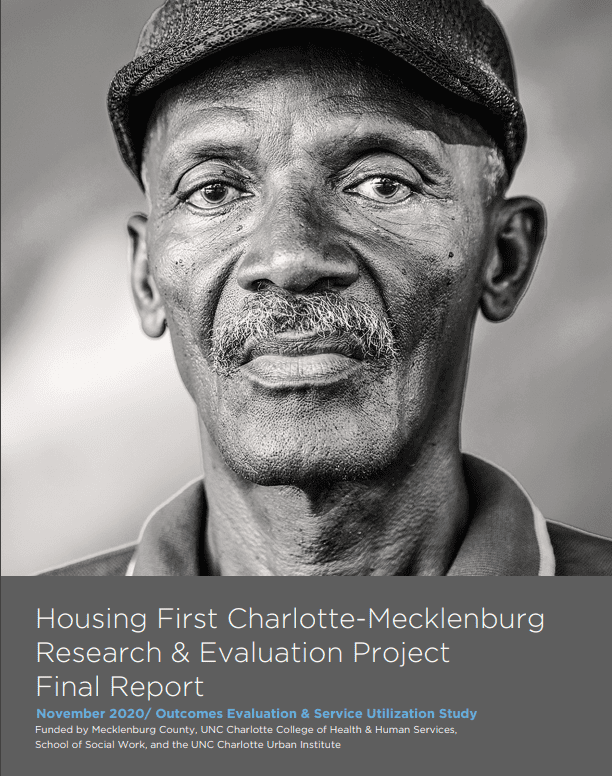Housing First works: Report sheds light on program to end homelessness

In the shadow of COVID-19, it’s easy to lose sight of the strides Charlotte-Mecklenburg has made to address chronic homelessness. Housing First Charlotte-Mecklenburg (HFCM) was launched in 2015 to end chronic homelessness in Charlotte-Mecklenburg by scaling housing first, particularly by expanding the housing first permanent supportive housing model.
Through HFCM and the continued work of the homeless services sector, over 1,000 individuals were housed between January 2015 and January 2020, the vast majority of whom remain in their housing.
Housing first programs reverse the order homeless services were traditionally given: A place to live is the first step, not the final reward for complying with services and addressing personal challenges like mental illness or substance use.
“Housing first” programs prioritize housing as an early step in service delivery; have low-barrier admissions policies; maximize client choice in housing and services; use a harm reduction approach to substance use and other personal challenges; and do not require service compliance or success in order for a tenant to maintain housing. The multi-sector collaborative HFCM effort included stakeholders from homeless services, local government, nonprofits, and the business community.
[Read the Outcomes & Utilization Evaluation Report here]
Today, the HFCM research team from UNC Charlotte, in partnership with Mecklenburg County, released the second of two summary reports from the multi-year research and evaluation project examining the effort. The Housing First Charlotte-Mecklenburg (HFCM) Outcomes & Utilization Report summarizes findings about the impact of housing provided through the multi-sector collaboration. The HFCM Process Evaluation Report was released in September and both reports are summarized in an Executive Summary also released today.
This blog post will highlight some of the key findings from the report and what they could mean for Charlotte-Mecklenburg.
[FAQs: Housing First Charlotte-Mecklenburg]
Housing First Improves Lives
Study participants who were housed through HFCM showed substantial improvements across multiple dimensions of their lives:
High Housing Retention. Housing Retention was high overall (73%), but highest for those in housing first permanent supportive housing (HF PSH) (80%). HF PSH secures housing through a permanent subsidy and builds stability through the ongoing availability of wrap-around services.
Better Quality of Life. Quality of life scores improved 30% after housing.
Fewer Mental Illness and Trauma Symptoms. Mental health symptoms decreased 35% and trauma-related symptoms decreased 26% after housing.
Reduced Substance Use. Housing first does not require sobriety or abstinence. However, after housing, the percent of housed participants that used any drugs fell 37%; and the number of days in the last month that housed participants used alcohol to the point of intoxication fell an average of 3 days more than it did for unhoused participants. Other substance use measures did not change, challenging criticism that housing first and harm reduction encourage substance use.
Quality of Life Improvements. When examined through a health economics lens of a quality adjusted life year (QALY), improvements in health-related quality of life because of housing first permanent supportive housing can be valued annually from $4,120 to $33,372 depending on the value assigned to a year of full and perfect health. This monetary estimation of health benefits is another way of understanding the benefits of housing first.
Housing First Reduces Service Use
Study participants who were housed through HFCM used fewer community services associated with homelessness including emergency shelters, criminal justice services and health services.
Fewer Nights in Emergency Shelter. The average number of nights in emergency shelter dropped by 93% for housed participants. Housing effectively ended the use of emergency shelter.
Fewer People Arrested and Fewer People Incarcerated. The share of housed individuals arrested fell 59% and share of housed individuals incarcerated fell 58%.
Fewer Health Department Visits. The percent of housed individuals using the Mecklenburg County Health Department fell 56% and the average number of visits in this group fell 71%.
Fewer Emergency Department (ED) Visits. The average number of ED visits fell 59%. On average, housed participants had 2 fewer visits to the ED than unhoused participants in the year after housing.
More Use of Crisis Assistance Ministry Financial & Furniture Services. Crisis Assistance Ministry provided security and utility deposits and furniture for some housed participants, but beyond these one-time move-in costs, use of financial assistance and furniture services increased after housing. Relative to unhoused participants, only 5% of housed participants used financial assistance before housing, but 24% used it after the immediate housing period. Only 2% used furniture services before housing, but 12% used the services after the housing period.
Costs of Housing are Partially Offset in Other Community Services. Based on the changes in service utilization, there is a $2.54 reduction in community services for every $10 invested in housing first permanent supportive housing. This savings reduces the average annual cost of housing first permanent supportive housing from $17,256 to $12,688.
The Housing First Response Can Improve
While these findings reflect a number of successes, the study suggests several key areas where Charlotte-Mecklenburg’s response to chronic homelessness could improve, including the following:
Similar Patterns of Inpatient and Outpatient Health Services Use. Housed participants continued to use inpatient and outpatient services at rates statistically similar to their use before they were housed. The impact of years without housing and/or access to preventative care may require some level of ongoing investment from the community to effectively address the level of care chronically unhoused individuals may need.
Continued Poor Perceptions of Physical Health. Housed participants’ perceptions of their own physical health improved slightly, however, scores on a standardized health assessment started and remained below those of the general U.S. population. Findings suggest opportunities to improve and better integrate health services.
Persistent & Worsening Food Insecurity. Rates of low and very low food security remained high at 83% for housed participants after housing; and increased 26.8 percentage points more for PSH participants than it did for non-PSH participants. This represents a 32% increase in the rate of low and very low food security. Given these findings, ensuring access to nutritious food should become an explicit part of the recognized service array of effective housing first practices in Charlotte-Mecklenburg.
Housing retention rates were lower for individuals placed in Rapid Re-Housing (provides short term subsidy and limited supportive services) or in permanent placements with family or friends (provides no subsidy or supportive services). If permanent, affordable housing and/or funding to provide long-term subsidies remains scarce, then further study of these models is warranted as is testing innovations that may increase their level of effectiveness.
So, What?
Through the use of local data, the Housing First Charlotte-Mecklenburg Outcomes & Utilization Report confirms national and international findings on the effectiveness of housing first, particularly permanent supportive housing, to end homelessness, improve people’s lives, and reduce use of emergency services. As an effective intervention, housing first is relatively low cost and given partial cost offsets and the potential economic, social, and personal value of benefits, it is the best available evidence-based practice to address and end chronic homelessness. The HFCM effort to end chronic homelessness housed over 1,000 individuals from January 2015 through January 2020, a substantial accomplishment in a tightening housing market with limited new resources.
Now, in the midst of a pandemic, the individuals who are housed in their own apartments can follow public health guidance that will keep them and the community safer. Just as we know that housing first works, we now know and see just important permanent, affordable housing is to keep everyone safe.
The key findings highlighted in this blog post are discussed in further detail in the full Housing First Charlotte-Mecklenburg (HFCM) Outcomes & Utilization Report.
The HFCM research team includes researchers from three UNC Charlotte colleges and the UNC Charlotte Urban Institute. The team also included several community research associates, including two peer research specialists. More than 20 students participated over the course of the project, several of whom now work full-time in local homeless services. Dr. Jennifer Troyer, Dean of the UNC Charlotte Belk School of Business, and Dr. Sam Tsemberis, a founder of the housing first permanent supportive housing philosophy, consulted on the research. The full research team is listed in the report.
A research project of this magnitude is only possible through the support and coordination of multiple partners and resources. The HFCM research and evaluation project received financial support from Mecklenburg County; Roof Above; the UNC Charlotte College of Health and Human Services, the School of Social Work; and the UNC Charlotte Urban Institute. We are also grateful to the many community leaders, service providers and individuals with lived experience in chronic homelessness who participated in the research and made this research project possible.
Contact Lori Thomas for more information about this report or the HFCM Research and Evaluation Project.
Lori Thomas is the Director of Research and Faculty Engagement at the UNC Charlotte Urban Institute, where she also directs the Institute for Social Capital Integrated Data System. She has been a faculty member in the UNC Charlotte School of Social Work for 12 years. She is the Principal Investigator of the HFCM Research and Evaluation Project
